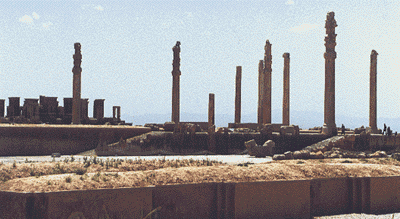


Another carving from Takht-e-Jamshid. This one shows a Zoroastrian religious symbol. There are still some Zoroastrians living in Iran, and this symbol is sometimes seen in contemporary art or jewelry.
 |
|
| As you might expect, Iran has plenty of great historical sites, both pre- and post-Islamic. These photos were taken at Takht-e-Jamshid, also known by the Greek name "Persepolis" (meaning "Persian City" or "Destroyer of Cities"), the royal city of ancient Persia. More than 2500 years ago, 10,000 workers at a time spent 120 years building this remarkable royal city, complete with running water and an underground sewer system. The city was destroyed by fire during the occupation of Alexander the Great (it had wooden ceilings and some wooden walls). Note the people on the right, beneath the columns, for scale. The smaller of these columns was as big as the others until the upper part collapsed in a storm just 10 years ago, by the way. | |
 |
|
| As the upper photo shows, the site is not nearly as well preserved as, say, the Acropolis. But in some ways it's more impressive. For instance, it retains a huge number of carefully carved figures like those above; some represent warriors, others represent people bearing tribute to the king. Note that in these carvings, the men have different beards, hats, and clothes, showing that they come from different tribes. | |
 |
|
Another carving from Takht-e-Jamshid. This one shows a Zoroastrian religious symbol. There are still some Zoroastrians living in Iran, and this symbol is sometimes seen in contemporary art or jewelry. |